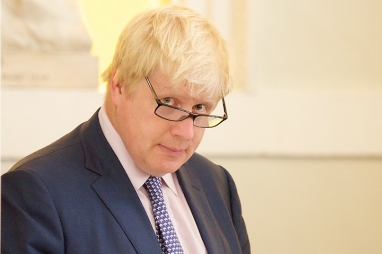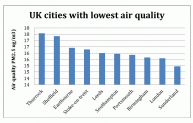EIC demands National Framework for low emission zones
Call for a National Framework based on London Mayor's proposal for ultra low emission zone so drivers and operators all work to the same standards.
Environmental trade body Environmental Industries Commission is urging UK government to implement a National Framework for Low Emission Zones in order to protect public health and bring UK air quality within World Health Organisation limits. The framework would use as its basis London Mayor Boris Johnson's ultra low emission zone plans for the capital.
The EU has recorded that UK cities like Sheffield, Stoke and Southampton all exceeded limits on air pollution.
“In London there are plans for an ultra low emission zone by 2020 and we would like to see other cities and towns given the freedom to copy the idea through a national framework,” said EIC executive director Matthew Farrow.
“We need a nationally recognised standard for emissions and vehicle identification – supported by a national certification scheme of retrofit technologies. This would reduce the cost and complexities of establishing Low Emission Zones for local authorities; facilitate consistency between Low Emission Zones and, therefore, reduce the cost and complexities of compliance for vehicle operators; and support national air quality objectives whilst maintaining local autonomy.”
The matter is becoming increasingly urgent for the UK which is already facing legal action from Europe over its failure to reduce nitrogen dioxide levels by 1 January 2010. Air pollution regularly exceeds the limits of the European Ambient Air Quality Directive in 16 zones across the UK and the main cause is road traffic with the biggest polluter being diesel engine exhaust fumes.
Poor air reducing life expectancy for everyone
Poor air quality is estimated to reduce the life expectancy of every person in the UK by an average of 7-8 months - impacting particularly on children, the elderly and those in poor health. According to recent estimates, poor air quality results in more than 29,000 premature deaths in the UK each year - more than twice as many per year as were caused by passive smoking before the ban.
The World Health Organisation has confirmed that air pollution causes cancer. Poor air quality also causes heart attacks and children living near busy roads in the UK have been shown to grow up with underdeveloped lungs. This problem is significantly worse in hotspot problem areas, such as cities.
Find out about the political parties views on air pollution at the EIC conference “Establishing a Green Agenda” on 2 December. More details here
A recent WHO report named several UK cities and towns that have particulate emissions higher than the WHO recommended averages of under 20 micrograms per cubic metre (µg/m3) for larger particles (PM10) and to under 10 µg/m3 for smaller particles (PM2.5). The major particulates found in air are sulfate, nitrates, ammonia, sodium chloride, black carbon, mineral dust and water.
In the UK Thurrock in Essex and Sheffield have the highest annual PM2.5 measurements (see chart) however more also needs to be done on monitoring with most of the figures for the WHO report coming from single monitoring stations dating back to 2011. “There should be real time displays on the streets telling us what the air quality readings are. That would really galvanise public awareness,” says Farrow.
A Defra spokesperson said: “Low Emission Zones (LEZs) provide a valuable opportunity to promote green growth and reduce air pollution caused by road transport and we work to promote the uptake of these schemes through programmes like our annual Air Quality Grant scheme.
“The government is also working with a number of authorities to examine the benefits of introducing new schemes to improve air quality, alongside the £2 billion we have already committed to increase uptake of ultra-low emission vehicles, sustainable travel and green transport initiatives."
According to EIC air quality group chair Michael Galey speaking at a recent Environmental Audit Committee “Defra has the will but not the money (to introduce a national framework); Department for Transport has the money but not the will.”
London Mayor's call for more regulation
The EIC's call came after London’s Mayor Boris Johnson asked Government to increase funding and strengthen regulation to reduce air pollution. He said that London’s Ultra Low Emission Zone effective from 2020 was at the heart of his plan and would see an extra charge levied at diesel vehicles entering the zone that do not meet the latest European standards (Euro 6).
Other measures in place include rolling out low emission electric vehicles across the city and retrofitting older vehicles with filters. “In terms of technical performance, the retrofit of a diesel particulate filter (DPF) system containing a ‘full wall-flow filter’ reduces emissions of particulate matter (PM) by around 99%,” says Galey.
In London TfL and the Department for Transport have retrofitted 900 buses with these filters which have been combined with selective catalytic reduction (SCR), which targets reducing of nitrous oxides. Johnson announced last week that a further 400 buses are to be fitted. “Typical results for a combined system such as the SCRT system would be particulate matter reduced by 99%, total NOx reduced by 90% and the NO2 component reduced by 55%. This would take a Euro III vehicle beyond the Euro V standard, and probably similar to a Euro VI vehicle in real-world operation,” says Galey.
Infraction proceedings
In February 2014 the Commission started infraction proceedings against the UK because the UK Supreme Court made a declaration that the UK was in breach of its obligations to comply with the limit values for Nitrogen Dioxide (NO2) in the Air Quality Directive. The infraction covers 16 zones (out of 43) which are the subject of the declaration made by the UK Supreme Court. These are zones for which the UK did not apply for a time extension under the Air Quality Directive because the Government could not demonstrate that they would meet the limit values by 2015.
Find out about the political parties views on air pollution at the EIC conference “Establishing a Green Agenda” on 2 December. More details here

